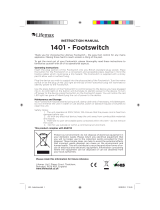
Important Safety Information
1. Read these instructions.
2. Keep these instructions.
3. Heed all warnings.
4. Follow all instructions.
5. This apparatus shall not be exposed
to dripping or splashing liquid and
no object lled with liquid, such as
a vase, should be placed on the ap-
paratus.
6. Clean only with a dry cloth.
7. Do not block any of the ventilation
openings. Install in accordance with
the manufacturer's instructions.
8. Do not install near any heat sources
such as radiators, heat registers,
stoves, or other apparatuses (includ-
ing ampliers) that produce heat.
9. Only use attachments/accessories
specied by the manufacturer.
10. Unplug this apparatus during light-
ning storms or when not in use for
long periods of time.
11. Do not override the intended pur-
pose of the polarized or grounding-
type plug. A polarized plug has
two blades, with one wider than
the other. A grounding-type plug
has two blades and a third ground-
ing prong. The wide blade, or third
prong, is provided for your safety.
If the provided plug does not t
your outlet, consult an electrician to
replace the obsolete outlet.
12. Protect the power cord from being
walked on or pinched, particularly at
the prongs, convenience receptacles,
the point where they exit from the
apparatus.
13. Use only with the cart
stand, tripod bracket,
or table specied by
the manufacture, or
sold with the ap-
paratus. When a cart is used, utilize
caution when moving the cart/ap-
paratus combination to avoid injury
from tip-over.
14. Refer all servicing to qualied service
personnel. Servicing is required if the
apparatus has been damaged in any
way, such as power-supply cord or
plug breakage, damage due to liquid
or objects falling onto the appara-
tus, exposure to rain or moisture, or
if the apparatus does not operate
normally, or has been dropped.
15. POWER ON/OFF SWITCH: For prod-
ucts with a power switch, the power
switch DOES NOT break the connec-
tion from the mains.
16. MAINS DISCONNECT: The plug
should remain readily operable.
For rack-mount or installation
where plug is not accessible, an
all-pole mains switch with a contact
separation of at least 3mm in each
pole shall be incorporated into the
electrical installation of the rack or
building.
17. FOR UNITS EQUIPPED WITH EXTER-
NALLY ACCESSIBLE FUSE RECEP-
TACLE: Replace fuse with same type
and rating only.
18. MULTIPLE-INPUT VOLTAGE: This
equipment may require the use of a
dierent line cord, attachment plug,
or both, depending on the available
power source at installation. Connect
this equipment only to the power
source indicated on the equipment
rear panel. To reduce the risk of re
or electric shock, refer servicing
to qualied service personnel or
equivalent.

























